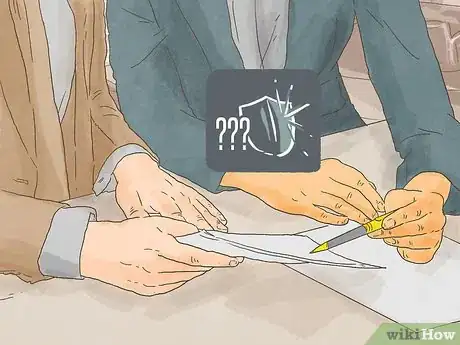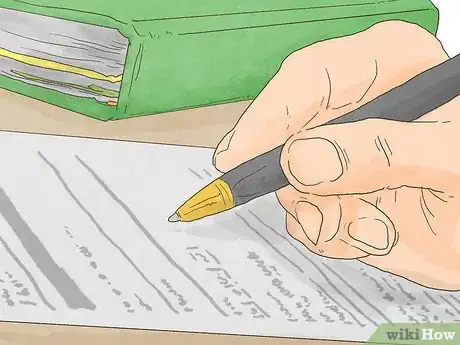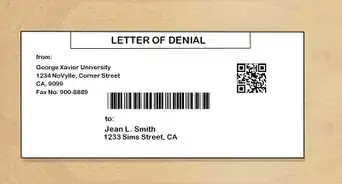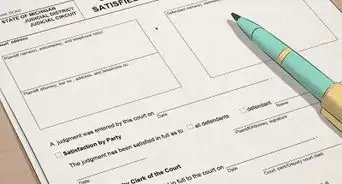This article was written by Jennifer Mueller, JD. Jennifer Mueller is an in-house legal expert at wikiHow. Jennifer reviews, fact-checks, and evaluates wikiHow's legal content to ensure thoroughness and accuracy. She received her JD from Indiana University Maurer School of Law in 2006.
There are 10 references cited in this article, which can be found at the bottom of the page.
This article has been viewed 39,731 times.
You've spent a lot of time and effort building assets, but a lawsuit could put that investment at risk. If you've already been sued, it's too late to take steps to protect your assets – laws in every state prohibit fraudulent transfers and last-minute actions to shield or hide assets from creditors and others to whom you're liable for damages. However, creating and implementing an asset protection plan early can help keep your assets secure from future lawsuits. Taking action well in advance is essential to protect your assets from a lawsuit.
Steps
Transferring Assets to Someone Else
-
1Research state and federal tax law. Even if you're simply giving title to a family member, you may owe federal and state gift tax on your transfers.
- The gift tax applies to any transfer of property ownership where you don't receive fair market value in return for the property.[1]
- IRS rules allow you to transfer up to $14,000 of property without paying the gift tax. However, there are no limits on the amount of property you can transfer to your spouse. This means you can freely put property of any value in your spouse's name without having to pay the federal gift tax.[2]
- However, when transferring property to your spouse you should keep in mind that your state tax laws may be different. Additionally, transferring property to your spouse could become problematic if you end up getting divorced.
- If the transfer you're planning is large or complicated, you might consider seeking advice from a tax attorney or an accountant. You also may need to hire an appraiser or surveyor to value your property.[3]
-
2Avoid fraudulent transfers. Each state has laws that allow someone suing you to come after assets you've transferred if you only transferred the property to protect it from the lawsuit.
- To prove you made a fraudulent transfer, the creditor must prove that you transferred your property to someone else, that you received less than the fair market value for that property, and that as a result you are unable to satisfy the judgment against you.
- By definition, if you gift assets to a friend or family member, you're receiving less than fair market value. The same would be true if, for example, you "sold" your car to your nephew for $5.
- Courts also look to various traits that legally are considered signs of a fraudulent transfer. For example, if you transfer title of your car over to your son who lives two states away, but you keep the car and continue driving it, the court would probably determine the transfer was fraudulent.
- Generally speaking, if you try to move your assets after you've already been sued, the court probably will determine that the transfer was an attempt to defraud the person who has a legitimate claim to money from you by making it look as though you have fewer assets than you actually do.
- For this reason, it is crucial to have an asset-protection plan in place long before anyone sues you.
- How far in advance you must transfer your property to avoid the presumption that the transfer was fraudulent varies among states. Typically transfers that took place more than four years before you were sued will be okay.
- With bankruptcy, courts closely scrutinize any transfers made within one year of the date you filed for bankruptcy. If the court determines any of these transfers was fraudulent, it may refuse to discharge some or all of your debts.
- If you've already been sued, typically a transfer will be considered fraudulent unless you can prove it occurred in the ordinary course of business. Essentially, you must be able to prove that the transfer would have been completed anyway, regardless of the lawsuit, and was not motivated by the lawsuit.
Advertisement -
3Draft the appropriate contracts. Depending on the type of property you transfer, you may need to record a written contract to make the transfer legally official.
- You can transfer ownership of any asset to family members – not just real estate. Assets you can transfer include securities, partnership interests, or even family heirlooms or antiques.
- In cases where no ownership document exists, you may want to draft a brief contract describing the conveyance and its character – whether sale or gift – to have an official record of the date the ownership was transferred. For example, if you transfer the ownership of antique furniture in your home to your spouse, but continue to live there, no one knows it's not really your furniture absent a contract to that effect.
- Ownership also can be held in an LLC or family limited partnership (FLP), which protects your assets by transferring ownership from you individually to the company or partnership.[4]
- Creating an LLC or an FLP allows you to transfer legal ownership of your assets while continuing to maintain control over the partnership and the assets themselves.[5]
-
4Sign and register your deed or title. If you're transferring real property or the title of a vehicle, you must execute transfer documents and record the transfer with the appropriate government agency or department in your state.
Using Pre-existing Legal Protections
-
1Research your state's law to find out what assets are protected. Each state has its own laws that keep creditors or other plaintiffs from enforcing a judgement against certain types of assets.
- Typically, personal property such as clothes and household furniture is exempt, as well as tools of a trade or business. For example, if you are a graphic designer or programmer, an asset such as your computer generally would be considered exempt.[6]
- Some states such as Texas even prohibit garnishment of your wages to satisfy a legal judgment.
-
2Transfer your cash savings to protected accounts. If you have significant cash assets, you may be able to protect at least a portion by putting it in an IRA or other type of retirement account that is protected from lawsuits by federal or state law.
- Protection for IRAs and other qualified retirement plans applies only in bankruptcy, not to judgments in other courts. ERISA plans are protected from all judgments except qualified domestic relations orders and IRS tax levies.[7]
- Many states have laws that protect certain retirement accounts, annuities, and life insurance from court judgments, but this is a matter of state law and varies widely.[8]
-
3Protect your home with the homestead exemption. Many states prohibit creditors or other plaintiffs from taking the home where you live.
- Some states offer unlimited protection, while others limit the homestead exemption to a certain amount of equity. What law applies depends on where the property is located and whether you keep it as your primary residence.[9]
- For example, if you live in Texas, you cannot be forced to sell your home to satisfy a court judgment, regardless of how much the home is worth. Limited exceptions include property division during a divorce or if you are sued by a lender and your obligation was secured by your house, such as a with a mortgage or home improvement loan.
-
4Strip equity from your assets. If you have additional property not covered by homestead or other exemptions, you can take out a loan and secure the loan's proceeds in a protected account.[10]
- For example, suppose you live in a state where annuities are protected from legal judgments and you own an apartment building. You can take out a loan against the building's equity and put the proceeds from the loan into an annuity, thus shielding that asset from judgment.[11]
Buying Umbrella Liability Insurance
-
1Determine whether you need umbrella insurance. You may need umbrella insurance if you have substantial assets or if there's a high risk you will be sued.
-
2Review your other insurance policies. Most insurance companies want you to have at least $250,000 in auto insurance and $300,000 in homeowner's insurance before they'll sell you an umbrella policy.[15]
- The umbrella policy doesn't kick in until you've reached the limit of your underlying policies.[16]
- If you don't already have that level of coverage, keep in mind how much increasing your coverage would add to your premiums.
-
3Calculate how much additional insurance you can afford. A $1 million personal umbrella liability policy typically will cost between $150 and $300 a year.[17]
- You should balance how much you can afford with how much you are likely to need. This amount will vary based on how at risk you are of being sued, and what the judgment is likely to be. Given the size of some personal injury judgments, $5 million might not even be enough. However, even a smaller umbrella policy offers the benefit of having the insurance company's legal team working in your defense.[18]
- You also can decrease your premiums by increasing your deductibles on your other policies. For example, if you have a $500 deductible on your auto insurance policy, but can afford a $2,000, that could lower your premium substantially.
-
4Search for discounts. You may be able to find discounted umbrella insurance, for example by purchasing your policy from the same company that provides your homeowner's insurance.
- Typically, if you want umbrella insurance you would talk to the company that already insures your home and car and have the umbrella policy added to your account.
- Consolidating your auto and home insurance with the same insurer can save you up to 20 percent on your premiums.
- You also can potentially save money by shopping around and comparing coverage and premiums offered by several different companies. If you can get better coverage for less from a different company, it might make sense to switch.
-
5Understand your policy's coverage limitations. Once you purchase your policy, you should read your coverage statement carefully so you understand which assets are covered and on what terms.
- If you own a boat or other recreational vehicles, keep in mind they may not be automatically covered by your homeowner's or auto policies. Typically you have to purchase separate coverage or specifically add them to your umbrella policy.
Creating an Irrevocable Living Trust
-
1Consider hiring an attorney. If you're considering holding your assets in a trust, an attorney who is experienced in state and federal law can help ensure your assets are protected.
- Some states such as Alaska and Nevada allow asset-protection trusts that keep your assets out of the reach of creditors and other court judgments, provided the statutory requirements are met.[19]
- Although you don't have to be a resident of the state to create an asset-protection trust there, you do have to keep some or all of the trust's assets in that state. Additionally, the independent trustee or trust company that administers your trust must be located and licensed in that state.[20]
- An attorney experienced in asset-protection trusts can ensure that your trust satisfies all regulatory requirements and doesn't violate any tax laws.[21]
- As with transferring ownership to another person, a court can invalidate a trust if a judge determines you created the trust with the intention of defrauding creditors or shielding your assets from a judgment.[22]
- The legal protection of trusts has limits. For example, most states don't allow protection against child support debt. Additionally, many states have exceptions for division of property in a divorce, particularly if you were married when you created the trust.[23]
-
2Research offshore jurisdictions. In some cases you may be able to better protect your assets by moving them to a bank overseas.
- Keep in mind that offshore trusts are expensive to create and maintain, so this is a viable option only if you have significant assets or pre-existing ties to another country.[24] For example, if you own a vacation property in The Bahamas, you might consider creating a trust there since you already own real estate in the country and presumably visit on a regular basis.
- Some countries require anyone trying to reach assets held in a trust to hire an attorney in that country and personally appear in court. This can decrease anyone's interest in going after those assets as it would be extremely expensive and time-consuming to do so.
- Historically, foreign trusts were considered more effective at protecting significant wealth and assets from lawsuits. However, at least 12 states now have laws allowing for the creation of asset-protection trusts. These domestic asset-protection trusts have most of the benefits of offshore trusts, but are generally less expensive to create and maintain.[25]
-
3Search for forms. Your state may have basic forms available that you can adapt to create your trust.
- Make sure whatever forms you decide to use are sufficient to create an irrevocable living trust. You may need to research your state's law to find out the legal requirements.
- An irrevocable trust is one you don't control and can't revoke. If you put money or assets in a trust you don't control, those assets are no longer considered yours. For this reason, they would be protected from most lawsuits.[26]
- The change in ownership means future legal judgments cannot be satisfied by those assets. This is true even if you've named yourself as the beneficiary of the trust.[27]
-
4Choose a trustee. When you create a trust, you must have a trustee to manage the assets held in the trust.
- Generally, the trustee must live in the state where you are creating the trust. If you use a bank or trust company, the company must be licensed to operate in that state.[28]
- The trustee also must be independent from you, meaning you can't select someone such as your spouse, your child, or your business partner as your trustee.[29]
- Choose your trustee wisely, keeping in mind that once your trust is created, he or she will have complete control over your assets and can distribute them or manage them using his or her own discretion.[30] [31]
-
5Draw up your trust documents. Once you've decided on a trustee, you can write up the documents that will define the parameters of your trust and describe what assets the trust will hold.
- Although you typically can create a basic living trust without an attorney, irrevocable trusts most often require drafting by a skilled and experienced attorney who has knowledge of the laws of the state in which you want to create your trust.[32]
- You must ensure that your transfer of assets to the trust complies with the fraudulent-transfer laws of the state where you're creating the trust as well as the state where you live, if those are two different states.[33]
- Generally, you should avoid placing real estate in the trust that isn't located in the state where you're creating the trust. Otherwise, that real estate could be used to satisfy a judgment against you, potentially allowing the creditor to gain access to the other trust assets as well.[34]
- For example, if you own a beach house in South Carolina but are creating an asset-protection trust in Tennessee, you generally shouldn't transfer ownership of your South Carolina beach house to your Tennessee trust.
-
6Sign your trust documents. You typically must sign your trust documents in the presence of a notary public.[35]
- After you've signed your trust, make copies and file or distribute them wherever is necessary. Keep your original documents in a safe deposit box or other equally safe place.
References
- ↑ https://www.irs.gov/businesses/small-businesses-self-employed/frequently-asked-questions-on-gift-taxes
- ↑ https://www.irs.gov/businesses/small-businesses-self-employed/frequently-asked-questions-on-gift-taxes
- ↑ https://www.irs.gov/businesses/small-businesses-self-employed/frequently-asked-questions-on-gift-taxes
- ↑ https://www.justia.com/estate-planning/asset-protection/
- ↑ https://www.justia.com/estate-planning/asset-protection/
- ↑ https://www.justia.com/estate-planning/asset-protection/
- ↑ http://www.investopedia.com/articles/retirement/07/buildawall.asp
- ↑ http://www.investopedia.com/articles/retirement/07/buildawall.asp
- ↑ http://www.investopedia.com/articles/retirement/07/buildawall.asp
- ↑ http://www.investopedia.com/articles/retirement/07/buildawall.asp
- ↑ http://www.investopedia.com/articles/retirement/07/buildawall.asp
- ↑ http://www.investopedia.com/articles/retirement/07/buildawall.asp
- ↑ https://online.citi.com/US/JRS/pandt/article.do?ID=JC25
- ↑ https://online.citi.com/US/JRS/pandt/article.do?ID=JC25
- ↑ http://www.iii.org/article/should-i-purchase-umbrella-liability-policy-0
- ↑ http://www.iii.org/article/should-i-purchase-umbrella-liability-policy-0
- ↑ http://www.iii.org/article/should-i-purchase-umbrella-liability-policy-0
- ↑ https://online.citi.com/US/JRS/pandt/article.do?ID=JC25
- ↑ http://www.investopedia.com/articles/retirement/07/buildawall.asp
- ↑ http://www.investopedia.com/articles/retirement/07/buildawall.asp
- ↑ http://www.investopedia.com/articles/retirement/07/buildawall.asp
- ↑ https://www.estateplanning.com/which-type-of-trust-protect-against-creditors/
- ↑ http://www.morganstanleyfa.com/public/projectfiles/3368068a-3af2-4587-a8bb-aa88cef9c68c.pdf
- ↑ http://www.investopedia.com/articles/retirement/07/buildawall.asp
- ↑ http://www.morganstanleyfa.com/public/projectfiles/3368068a-3af2-4587-a8bb-aa88cef9c68c.pdf
- ↑ http://www.nolo.com/legal-encyclopedia/do-living-trusts-protect-assets-creditors.html
- ↑ https://www.estateplanning.com/which-type-of-trust-protect-against-creditors/
- ↑ http://www.investopedia.com/articles/retirement/07/buildawall.asp
- ↑ http://www.morganstanleyfa.com/public/projectfiles/3368068a-3af2-4587-a8bb-aa88cef9c68c.pdf
- ↑ https://www.estateplanning.com/which-type-of-trust-protect-against-creditors/
- ↑ http://www.morganstanleyfa.com/public/projectfiles/3368068a-3af2-4587-a8bb-aa88cef9c68c.pdf
- ↑ http://www.nolo.com/legal-encyclopedia/irrevocable-living-trusts.html
- ↑ http://www.morganstanleyfa.com/public/projectfiles/3368068a-3af2-4587-a8bb-aa88cef9c68c.pdf
- ↑ http://www.morganstanleyfa.com/public/projectfiles/3368068a-3af2-4587-a8bb-aa88cef9c68c.pdf
- ↑ http://www.nolo.com/legal-encyclopedia/living-trust-v-will.html















































































